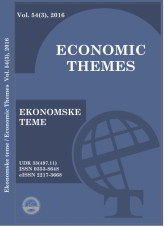Economic Themes (2016) 54 (3) 7, 449-468
Duško Ranisavljević, Miroljub Hadžić
Abstract: As a rule, long-term bank loans entail solid security – a mortgage, regardless of their purpose. The mortgaged property has its specific market value during the loan approval period but during the repayment period, the value of the real estate varies. This is the reason why the initially specified indicator of the coverage of loans with the value of the mortgage - the LTV ratio changes, which in turn increases the risk of loan repayment. The aim of this paper is to draw attention to the necessity of establishing adequate initial LTV ratios (together with other important ratios). This would help nullify the risk of any variations in real estate prices, the loan currency risk, the interest rate risk, as well as the risk of an increase in bank's claims because of a long foreclosure process. The paper analyses effects of changes in LTV ratios caused by varying circumstances using the case study method. The comparative method analyses the changing trends of data on the LTV ratios for the already approved loans over a seven-year period by comparing the flow of the loan capital sum with the real value of the mortgage for three types of loans. The conclusion reached is that commercial banks should establish the initial LTV ratio for various long-term loan products and thus prevent its rise. Banks should do this by taking into account all the factors that cause the ratio’s increase, and thus give preference to the reduction of the credit risk and not the attractiveness and accessibility of loan products.
Keywords: mortgage value; real estate market; LTV; credit risks
REALISTIC EVALUATION OF THE RATIO: LOAN-TO- VALUE – THE KEY TO MINIMISING THE CREDIT RISK
Duško Ranisavljević, Miroljub Hadžić
Abstract: As a rule, long-term bank loans entail solid security – a mortgage, regardless of their purpose. The mortgaged property has its specific market value during the loan approval period but during the repayment period, the value of the real estate varies. This is the reason why the initially specified indicator of the coverage of loans with the value of the mortgage - the LTV ratio changes, which in turn increases the risk of loan repayment. The aim of this paper is to draw attention to the necessity of establishing adequate initial LTV ratios (together with other important ratios). This would help nullify the risk of any variations in real estate prices, the loan currency risk, the interest rate risk, as well as the risk of an increase in bank's claims because of a long foreclosure process. The paper analyses effects of changes in LTV ratios caused by varying circumstances using the case study method. The comparative method analyses the changing trends of data on the LTV ratios for the already approved loans over a seven-year period by comparing the flow of the loan capital sum with the real value of the mortgage for three types of loans. The conclusion reached is that commercial banks should establish the initial LTV ratio for various long-term loan products and thus prevent its rise. Banks should do this by taking into account all the factors that cause the ratio’s increase, and thus give preference to the reduction of the credit risk and not the attractiveness and accessibility of loan products.
Keywords: mortgage value; real estate market; LTV; credit risks

